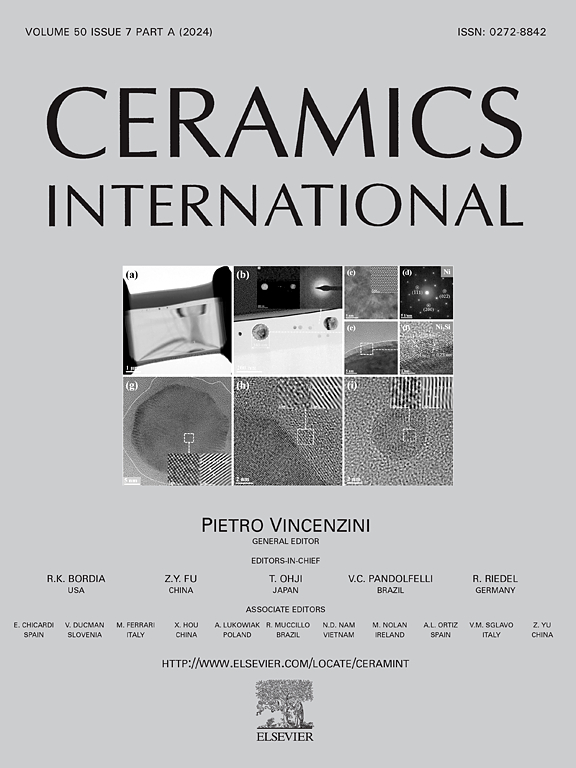The relationship between current-time curve and dynamic equilibrium of oxide growth-dissolution in titanium anodization
IF 5.6
2区 材料科学
Q1 MATERIALS SCIENCE, CERAMICS
引用次数: 0
Abstract
The dynamics of growth of anodic TiO2 nanotubes and the field-assisted dissolution theory are still highly controversial. The physical significance of the three stages of the current-time curve is still unclear, and the equilibrium between oxide growth and field-assisted dissolution during anodizing process has never been experimentally verified. In this paper, the anodizing processes of three Ti substrates were studied in order to investigate the connection between the above theories and experiments. It was found that the nanotube arrays with uniform length and high opening porosity were more easily obtained by the Ti substrates which were pre-anodized and then artificially stripped nanotubes. An innovative method combining two anodizing processes that first at high voltage and then at low voltage, which was designed to verify that the equilibrium between oxide growth and field-assisted dissolution does not exist. The reason why the current remains stable and constant at different voltages is determined by the critical thickness of the barrier layer with voltage-dependent, rather than the equilibrium between oxide growth and field-assisted dissolution. The motivation of nanotubes growth is such that the ionic current determines growth of oxide, and the electronic current determines the oxygen bubble mold which form nanotubes.
钛阳极氧化过程中电流-时间曲线与氧化生长-溶解动态平衡的关系
阳极TiO2纳米管的生长动力学和场辅助溶解理论仍然存在很大的争议。电流-时间曲线的三个阶段的物理意义尚不清楚,阳极氧化过程中氧化物生长和场辅助溶解之间的平衡也从未得到实验验证。本文研究了三种Ti衬底的阳极氧化过程,探讨了上述理论和实验之间的联系。结果表明,在钛基体上进行预阳极氧化后,人工剥离纳米管更容易得到长度均匀、开孔率高的纳米管阵列。一种结合高压和低压两种阳极氧化工艺的创新方法,旨在验证氧化物生长和场辅助溶解之间不存在平衡。电流在不同电压下保持稳定和恒定的原因是电压依赖的势垒层的临界厚度,而不是氧化物生长和场辅助溶解之间的平衡。纳米管生长的动力是离子电流决定氧化物的生长,电子电流决定形成纳米管的氧泡模。
本文章由计算机程序翻译,如有差异,请以英文原文为准。
求助全文
约1分钟内获得全文
求助全文
来源期刊

Ceramics International
工程技术-材料科学:硅酸盐
CiteScore
9.40
自引率
15.40%
发文量
4558
审稿时长
25 days
期刊介绍:
Ceramics International covers the science of advanced ceramic materials. The journal encourages contributions that demonstrate how an understanding of the basic chemical and physical phenomena may direct materials design and stimulate ideas for new or improved processing techniques, in order to obtain materials with desired structural features and properties.
Ceramics International covers oxide and non-oxide ceramics, functional glasses, glass ceramics, amorphous inorganic non-metallic materials (and their combinations with metal and organic materials), in the form of particulates, dense or porous bodies, thin/thick films and laminated, graded and composite structures. Process related topics such as ceramic-ceramic joints or joining ceramics with dissimilar materials, as well as surface finishing and conditioning are also covered. Besides traditional processing techniques, manufacturing routes of interest include innovative procedures benefiting from externally applied stresses, electromagnetic fields and energetic beams, as well as top-down and self-assembly nanotechnology approaches. In addition, the journal welcomes submissions on bio-inspired and bio-enabled materials designs, experimentally validated multi scale modelling and simulation for materials design, and the use of the most advanced chemical and physical characterization techniques of structure, properties and behaviour.
Technologically relevant low-dimensional systems are a particular focus of Ceramics International. These include 0, 1 and 2-D nanomaterials (also covering CNTs, graphene and related materials, and diamond-like carbons), their nanocomposites, as well as nano-hybrids and hierarchical multifunctional nanostructures that might integrate molecular, biological and electronic components.
 求助内容:
求助内容: 应助结果提醒方式:
应助结果提醒方式:


